How to make your own Sourdough Starter, using simple ingredients with no special equipment, in just six days, that can be used in our sourdough bread. Video.
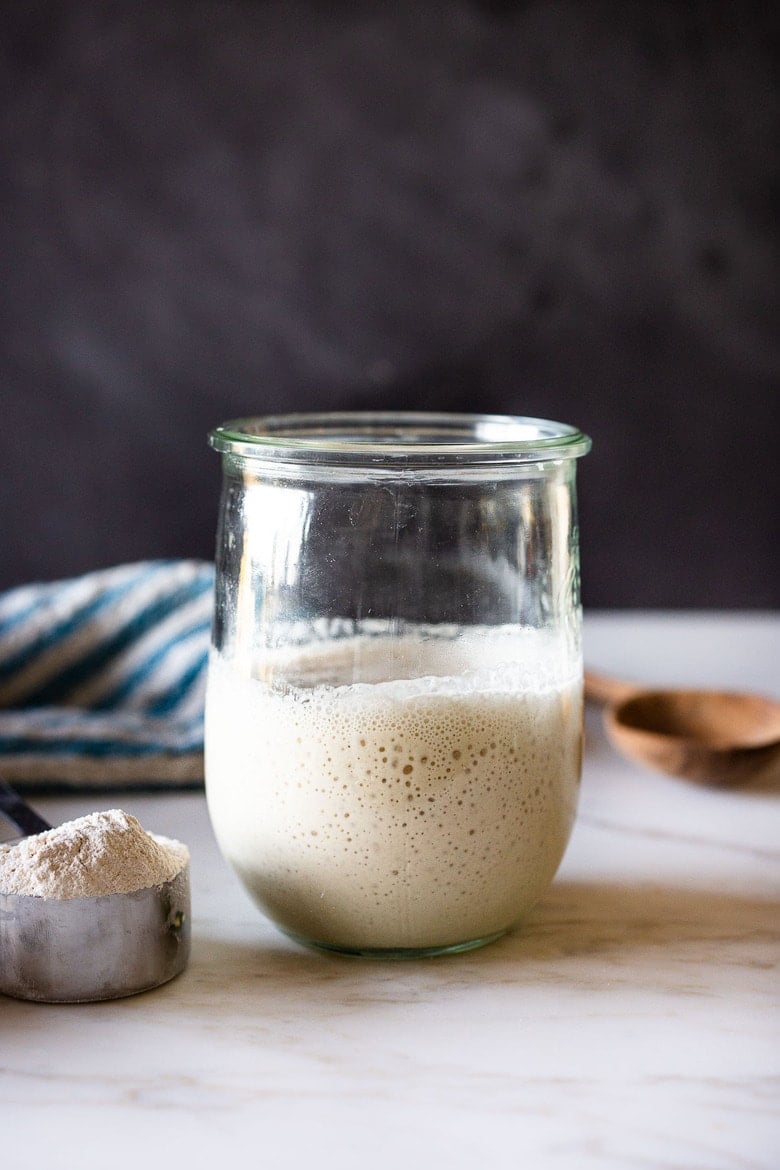
When you understand one thing through and through, you understand everything.~ Shunryu Suzuki
With over 500 five-star reviews and hundreds of success stories, my chef’s perfected sourdough starter guide has everything you need to make your own homemade starter. In just six days, you’ll be baking the most beautiful sourdough loaves!
But first, What is a starter?
Sourdough starter is a “wild yeast” made from flour, water, and the natural wild yeast in the air. With a little care and patience, it ferments, and when strong and active, just a little bit of starter replaces commercial yeast and makes your bread rise, while transforming the gluten in the bread into something more easily digestible. Store-bought yeast is not needed!
How to Make Sourdough Starter | 20-Min Video
***Don’t see the video? Allow 15-20 seconds to load it right here!*** (Still don’t see it? Check that your ad blocker is turned off; use Chrome for the best experience.)
Fast forward to Specific Day by video time (using scroll bar underneath video)
- Day 1 Morning: :23
- Day 2 Morning: 4:10
- Day 3 Morning: 7:00
- Day 3 Evening: 9:12
- Day 4 Morning: 11:50
- Day 4 Evening: 13:37
- Day 5 Morning: 14:45
- Day 6 Evening: 16:50
- Day 6 Morning: 18:12
- Day 6 Evening: 20:10
Sourdough Starter Recipe Ingredients
- Jar – A wide-mouth quart jar or a Weck’s 1-liter tulip jar.
- Flour – 5 lb bag of organic bread flour (plus 1 cup organic whole grain flour )
- Water – filtered water, tap water, or mineral water (specifically, San Pellegrino, for the correct mineral ratio). Distilled water does not have enough minerals.
- Scale – using a kitchen scale is optional but handy.
- Thermometer – Knowing the temp of the starter using a thermometer is optional but handy!
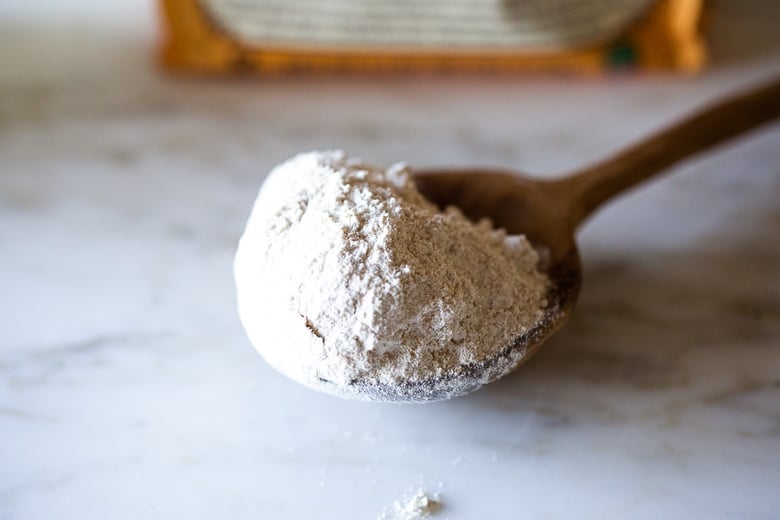
Understanding starter
- Think of sourdough starter as yeast. Only in this case, instead of buying a packet of yeast from the store, you are making your own living “wild yeast” by fermenting flour and water. Once it’s bubbly and happy, it is very much ike a very low-maintenance pet.
- You must feed it (stir in a mixture of flour and water) once a week to keep it active and strong. You know it’s happy when it bubbles. 😉 And YES, you can even name it.
- Some people believe that bread made with sourdough starter is actually better for you than bread made with yeast. Here and Here are a few articles to get you started on your own research. While I’m not sure if this is scientifically proven, I do know that bread made with sourdough starter, tastes infinitely better, feels easier to digest, and has more complexity and better texture, than bread made with commercial yeast. So if you are a bread lover- this is absolutely the way to go, as far as the quality of your finished bread.
How to Make Sourdough Starter
*See the recipe card for detailed instructions.
This recipe for Sourdough Starter takes 6 days (or up to 12 days if it is very cold where you live). For a primer, watch the 20-minute Sourdough Video above!
Day 1: Staring in the morning or at night, using a wide-mouth quart jar, tulip jar, or Crock or Glass Measuring Cup , mix 1 cup whole grain flour (120 grams) with 1/2 cup filtered water (120 grams) using a fork (or chopstick) making sure you’ve incorporated all the dry flour.
Place the lid lightly on top (using the Weck jar lid is really handy here) or a wet towel to keep moisture in, or plastic wrap- and let sit at room temperature (70-ish degrees) on the kitchen counter for 24-48 hours. If you are unsure how warm it is, use a kitchen thermometer and check it a few hours later. See notes for TEMPERATURE.
TIP #1: For your first measurement, weigh the flour using a kitchen scale so you can get an idea of how the mixture should feel. Do not weigh the measuring cup! It should be like a thick paste, like peanut butter. If you need to add a little more water to incorporate the flour, that is OK too!
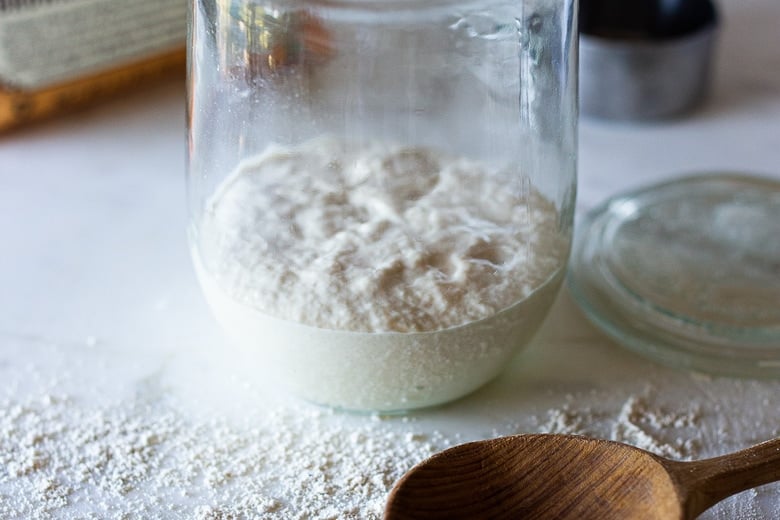
Day 2: After the first 24 hours, there may or may not be a bit of bubbling. Let the mixture rest until you see activity (bubbles or rising) sometimes this takes 36 hours or even 48 hours if very cold. When you see active bubbling, discard all but 1/2 cup of the starter (4 ounces).
To the remaining ½ cup of starter, stir in 1/2 cup water (120 grams), and mix well with a fork. Add 1 cup of organic bread flour (120 grams)spooned and leveled. Stir until combined. Again, it should feel like a thick paste. If overly dry, feel free to add a bit more water. Cover again and allow the mixture to sit at room temperature for another 24 hours.
Day 3: After 24 hours, hopefully, you will see some bubbling or rising and if not, let it go a bit longer until you see activity. Be patient.
Depending on how warm your house is and how active your starter, you may need to begin feeding more often or move to two feedings a day, in the morning and at night. If it is cold, one feeding a day may be enough.
TIP #2: Only feed the starter after it has peaked or looks hungry. See the “3 Signs of Hunger” below. Feeding it when it is “not hungry” will basically dilute all the growing yeast and make it lethargic. Better to underfeed than overfeed.
The 3 Signs of hunger
The photo below was taken after the starter was fed, and after it peaked (reached its highest), and now is sliding down. It is now “hungry” again. See the downward slide marks on the jar? Pay attention – your starter is telling you it is hungry.
- Look for “slide marks” (be sure to use a clean jar so you can see these clearly).
- Liquid at the top of the starter.
- Thin and runny. The starter is liquidy enough to pour out of the jar (when at room temp).

This might be 12 hours, it might be 14, it might be 18, or 24, depending on the temp in your house. In very warm climates, it may only be 6-8 hours. In winter, this may take 36 hours. It is better to underfeed rather than overfeed here.
For each feeding, discard all but 1/2 cup of the starter (keeping roughly ½-cup of starter in the jar). Add 1/2 cup water and 1 cup Bread Flour (spooned and leveled). Mix well, cover, and let this rest at room temperature for 12-24 hours or until the starter looks “hungry” again before repeating.
Day 4: Feed 1-2 times, discarding all but 1/2 cup of starter each time. Feed 1 cup bread flour, 1/2 cup water.
TIP #3: It is typical on day 4 for the starter to slow down and stall a bit. This is OK. Just keep going, be patient and look for the hunger signs, and only feed when clearly hungry. Hopefully, you’ll begin to see some rising and falling. It’s helpful to put the starter in a clean jar each day and mark the beginning level (with a sharpie, string or rubber band) so you can easily see this.
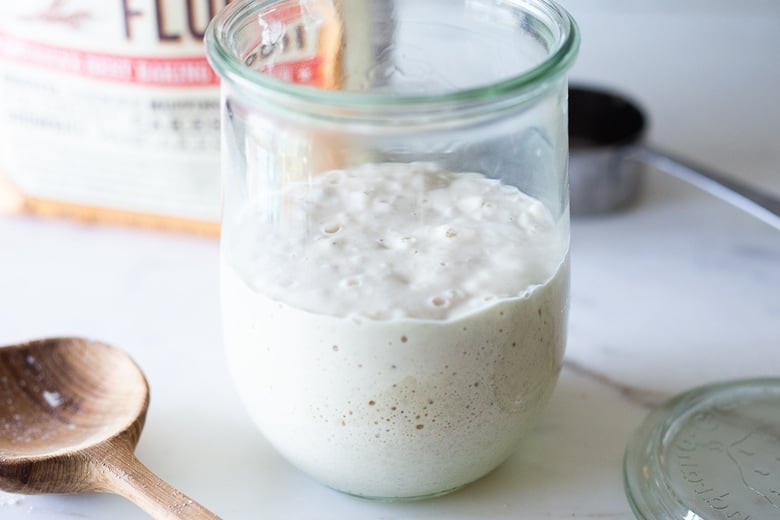
Above, you’ll see it peaking, and below, you’ll see it deflating and getting “hungry.” There may not be too much difference in the beginning, so look closely.
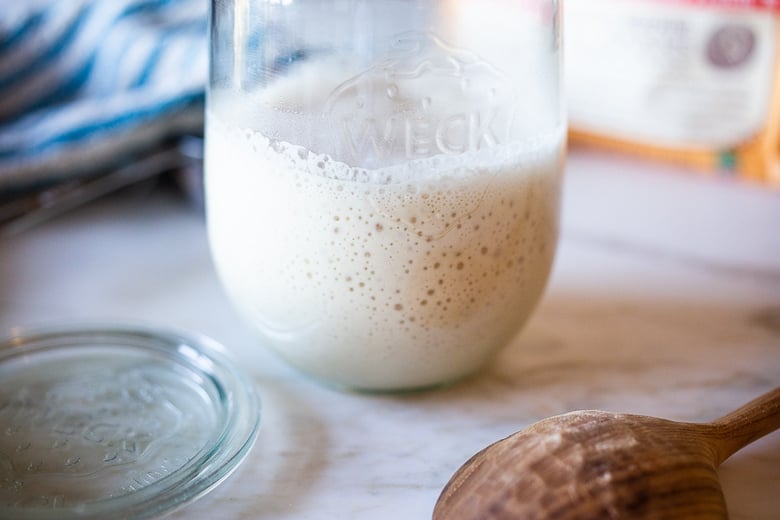
Understand that your starter has a schedule of its own; it is a living thing, so watch it and pay attention.
If your starter is not rising and falling, look at its consistency. As it metabolizes the flour and gets hungry, it will get runny and liquidy, like to the point where you can pour it right out of the jar. If it is still thick like paste, it’s not done metabolizing (eating)the flour.
Day 5: Feed again, 1-2 times, discarding all but a 1/2 cup the starter each time. Adding 1 cup bread flour and 1/2 cup lukewarm water. The starter should look visibly active, bubbling, rising, hopefully, close to doubling in size.
Repeat day 5 until the starter is rising and falling predictably and is close to doubling in size within 6-8 hours.
TIP #4: If your starter is not rising but there is evidence of hunger (liquidy or liquid at the top) try 3 things: substitute 1/4 cup whole grain flour (add to ¾ cup white bread flour) on your next feeding. Try using mineral water like San Pellegrino instead of water. Stir the starter a few times after feeding to allow more wild yeast from the kithcen to get inside.
DAY 6 Morning: Baking day! Give it one last feeding in the morning: this time discard all but a 1/3 cup. (The reason we are changing this to 1/3 cup is to feed it a little bit more.) Add 1 cup flour (120 grams) and 1/2 cup water, stir, and place it in a clean jar so you can see the action clearly. You can use a sharpie or place a rubber band around the jar to mark the beginning level. The starter should hopefully double in volume within 6-8 hours of feeding.
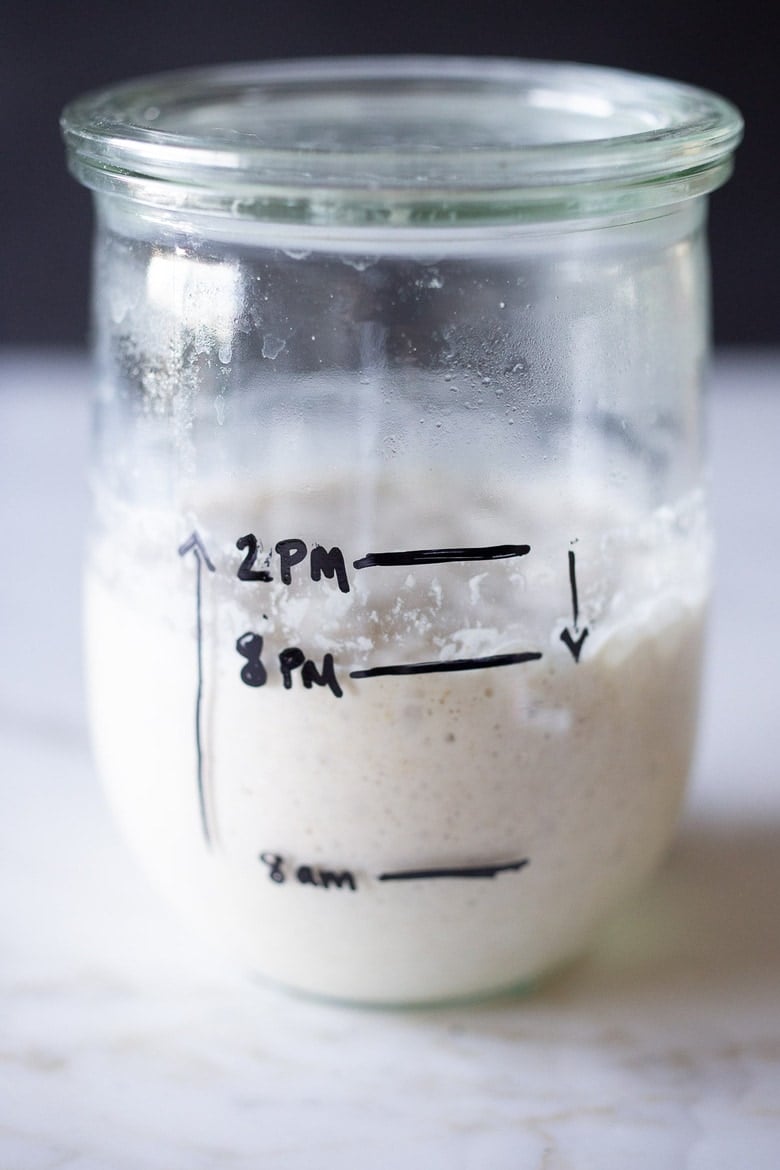
In the photo above, on the 6th day, the starter was fed at 8 am, it peaked around 2 pm, then it started deflating, and by 8 pm, it was “hungry” again. See those downward “slide” marks on the jar?
DO THE FLOAT TEST: When the starter is at its peak, or just after, place a teaspoon of starter (just from the top, don’t stir it down) in a glass full of water; it should hopefully float. If it floats, success!!! Congrats. You can now make our sourdough bread…tonight!
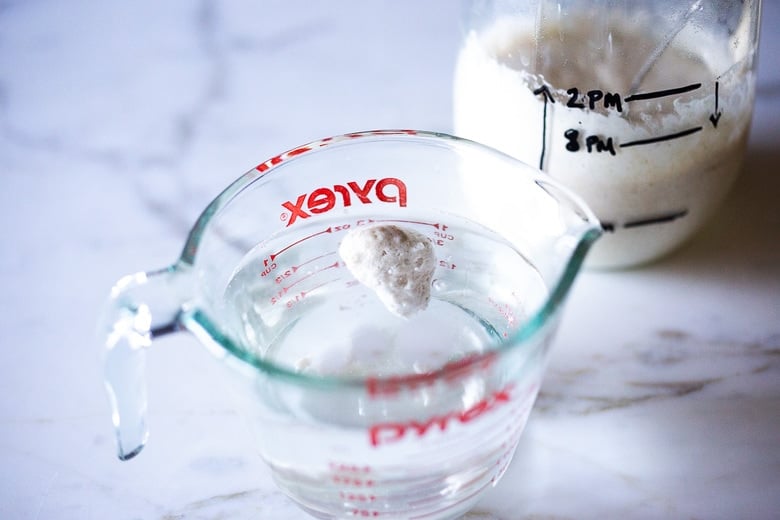
TIP #5: When baking bread always use hungry starter that has already peaked!
STARTER DOES NOT FLOAT? If it doubles in size but does not float, you can still try baking a loaf if it doubles within 6-8 hours of feeding it.
At this point, if your starter does not double in size within 6-8 hours of feeding, don’t give up! Often, it just takes longer, especially during the winter months. Continue feeding one to two times a day until you see a consistent, predictable rise and fall.
Read the troubleshooting section. If you need to take a break, put it in the fridge and try it again up to a week later. Don’t toss it!
Day 6 Evening: Let’s Bake! Use 1/3 cup starter to make this sourdough bread recipe and place the remaining starter (or if not making bread, place all of it) in the refrigerator, and feed it at least once a week, reserving ½ cup starter, before feeding it the usual 1 cup bread flour, 1/2 cup water.
TROUBLESHOOTING Starter
- SMELL: Starter should smell sweet, tangy, earthy, like a wet horse – not “bad”. If it really smells foul or unpleasant, you may have used an unclean jar, unclean utensil, or somehow introduced other bad bacteria. I would start over.
- NO ACTION: On day 4-5 it is typically for it to slow down. If your starter is not rising at all but there is evidence of hunger (liquid at the top, or bubbles) try 3 things. First substitute 1/4 cup whole grain flour (add to ¾ cup white bread flour) on your next feeding. If no rise, then try using mineral water, specifically San Pellegrino instead of water. San Pelligrino specifically has the right mineral ratio, I have great luck with it. Others not so much! Also try stirring the starter a couple of hours after feeding, a couple of times throughout the day to allow wild yeast from the room to get in there. Lastly, you could try pineapple juice instead of water.
- FLOUR: Try to use fresh milled whole grain flour to start, then organic BREAD FLOUR. The more wild yeast in the flour, the better your starter will do- so smaller brands like Bob’s Red Mill seem to do better than bigger conventional brands that have been overly processed. It is totally OK to mix flours and to switch them up- this adds different kinds of wild yeast- a good thing!
- DO NOT overfeed. For example, maybe feeding 2 x day at 12-hour intervals is too often. You want to feed after the starter has peaked, then deflated (see photo above- you’ll see some slide marks on the jar) and this tells you that it is hungry. If you feed the starter before it has had a chance to metabolize (or eat) all the flour (before peaking) and then you discard part of it, and feed it again, you are actually diluting all that amazing bacteria, weakening your starter. So it’s all about watching your starter in your home. If you are not seeing rising and falling, but notice the starter just gets liquidy, this too is a sign of “hunger”. Or if it gets runny enough to pour out of the jar, another sign it is hungry. There are lots of variables here. Just be patient, pay attention and watch. This is a living thing- it doesn’t care about time schedules and recipes or what it “should” do. It will “eat” when it is “hungry” and sometimes it likes to eat slowly. 😉
- TIME: It may take longer than 6 days in colder environments. Use a kitchen thermometer and take its temp. Is it over 65F? Find a place where it can be warm. In the oven with the light on, or in an upper cupboard ( heat rises). Sometimes it takes 12-14 days! Be patient, keep going. If it is doing absolutely nothing, leave it out on the counter for 24-48 hours and see what happens. If you run out of flour or need a break, don’t just toss it, put it in the fridge and see if you can get it going a few days later.
- ACIDITY: If you still can’t get that starter going, some people recommend subbing pineapple juice for the water for one feeding- raising the acidity level. My good friend just tried this and it got hers going.
- LIQUID: If you see any liquid at the top of your starter, it means your starter is hungry. So, yes it’s still alive which is a good thing! You can stir the liquid in, or pour the liquid out, either way, but feed it. This is a sign that you may need to feed it more often.
- MOLD: if you see any discoloring or mold on the surface, starter was probably contaminated. If it is only on the surface, it is probably ok to save. Scrape it off, save 1/2 cup of the underneath starter, and keep going, using a clean jar. Feed, smell, use your best judgment.
- FLOAT TEST: Try testing when your starter is peaking. Take a spoonful from the top without stirring it down. If your starter is rising and falling consistently, but not passing the float test and it has been over 8-10 days- just try baking a loaf. People are having luck with good loaves without passing the float test. It may be the flour…
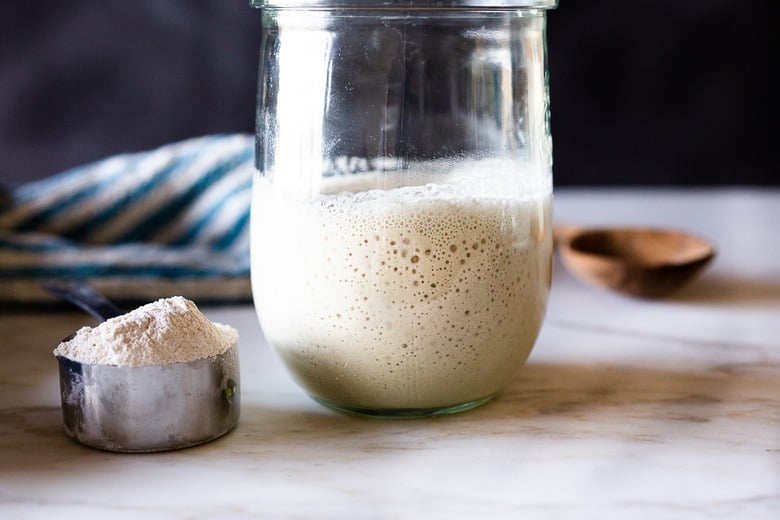
How to Maintain Your Starter
- REFRIGERATE & FEED AT LEAST ONCE A WEEK: Pick a scheduled day and try to stick with it, always reserving 1/2 cup and feeding it 1 cup flour and 1/2 cup water. Discard the remaining, give it away, or keep the discard in a separate container for sourdough pancakes, sourdough buns, banana bread, biscuits, etc. I usually don’t feed the discard unless I give it away.
- If you forget to feed it one week, it is most likely OK; feed it 1-2 times a day for 1-3 days in a row to revive it (keeping it out on the counter) until bubbly and active and doubles within 6 hours. I’ve left my starter for a month on vacation (in the fridge) without feeding and simply revived it by feeding it 3 days in a row, 1-2 x day. It’s surprisingly hard to kill. You can also freeze it for more extended storage.
- This batch will allow you to bake 2 loaves of bread per week with enough left to feed for the next week. If you want to bake more often, you can keep it out and feed it 1-2 x daily. Or if baking every few days, you can pull it out of the fridge, feed it 10 hours before using, leaving it out, use what you need while it is peaking (or slightly after), then put it back in the fridge that evening. Do the same thing a few days later when ready to use again. So this would be feeding 2-3 times a week, best if baking 4-5 times a week.
The best time to use sourdough starter is just after it peaks or on its way down when you know it is hungry.
Sourdough Bread Starter FAQs
Yes. While you are building your starter, during the first week, it is the simplest, easiest, fastest, and most economical way to create a healthy starter. (Or save it separately -in the fridge- and use it in Pancakes, Waffles, Buns, or Biscuits. ) This is because you always have to feed it two times its volume in flour. For example-if you kept all the 1 1/2 cups of starter, you would have to feed it 3 cups of flour (instead of keeping just a 1/2 cup and only feeding it ONE cup). Discarding will shorten the fermentation process, require less flour in the long run, and create a stronger starter. Once your starter is “established” after the first week- then you can give it away to friends, use it in pizza dough, pancakes, etc) or give it to a friend.
How to use your Sourdough Starter
- See all our Sourdough Recipes!
- Sourdough Scones
- Sourdough Crackers
- Sourdough Biscuits
- Sourdough Buns
- Sourdough Tortillas!
- Vegan Banana Bread
- Overnight Sourdough Waffles
More from Feasting At Home
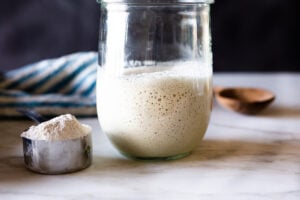
Simple Sourdough Starter
- Prep Time: 30
- Cook Time: 6 days
- Total Time: 144 hours 30 minutes
- Yield: 1 ½ cups
- Category: sourdough, fermented, cultured, bread, baking,
- Method: fermented
- Cuisine: bread
- Diet: Vegan
Description
How to make your own Sourdough Starter (see the step-by-step video in post) using simple ingredients with no special equipment, in 6 days, that can be used in sourdough bread. Sourdough Starter is a wild yeast, made from fermenting flour and water.
Ingredients
- 120 grams whole grain flour (whole wheat flour, rye flour, or freshly milled flour) 1 cup, fluffed, spooned and leveled
- Organic White Bread Flour (5-10 lb bag ) I like Shepherd’s Grain or Bob’s Red Mill.
- 120 grams Water per feeding (1/2 cup water)
Instructions
-
- Day 1: Starting in the morning or at night, using a wide-mouth quart jar or Crock or Glass Measuring Cup mix 1 cup whole grain flour (120 grams) with 1/2 cup (120 grams) filtered water using a fork making sure you’ve incorporated all the dry flour. For your first measuring – it is a good idea to weigh the flour, using a kitchen scale so you get an idea of how thick it should feel. It should be like a thick paste. Thick like peanut butter. If you need to add a little more water to incorporate the flour, that is OK, but be precise with the flour. Place the lid on top (using the Weck jar is really handy here) or a damp towel to keep moisture in, or plastic wrap- and let sit at room temperature (70-80 degrees) on the kitchen counter for 24-48 hours, or until you see some bubbling. If you are not sure how warm it is, use a kitchen thermometer and check it a few hours later. See notes for TEMPERATURE.
- Day 2: After the first 24 hours, you may or may not see a bit of bubbling. I prefer to let this rest until I see a tiny bit of activity (bubbles) and sometimes this takes 36 or up to 48 hours. So start “day 2”, when you see a little bit of bubbing. Discard all but 1/2 cup (136 grams) of the starter. (See notes for discard). Add to the remainder, 1 cup of white bread flour, (120 grams), spooned and leveled, and 1/2 cup filtered water (120 grams), mixing well with a fork. Place the lid on loosely again and allow the mixture to sit at room temperature (70-80F) for another 24 hours.
- Day 3: By the third day, you should definitely see some bubbling- and if not, let it go a bit longer. Depending on how warm your house is and how active your starter, you may need to begin feeding more often, or even move to two feedings a day roughly 12 hours apart, like in the morning and at night. In a nutshell, you want to feed the starter only after it has peaked (metabolized all the flour from the last feeding) and has started sinking down or gets liquidy- this is when it is hungry! This might be 12 hours, it might be 14, it might be 18, or 24, depending on the temp in your house. In very warm climates it may only be 8 hours. It is better to underfeed rather than overfeed here. For each feeding, like before, discard all but 1/2 cup of the STARTER (keeping roughly ½-cup of starter in the jar -4 ounces or 136 grams) Add 1 cup Bread Flour (spooned and leveled) and 1/2 cup water to the 1/2 cup starter and let this rest at room temperature for 12-24 hours or until the starter looks “hungry” again before repeating.
- Day 4: Feed 1-2 times, discarding all but 1/2 cup of starter EACH TIME. Feed 1 cup bread flour, 1/2 cup water. Look for the hunger signs. Hopefully, you’ll begin to see some rising and falling. It’s helpful to put the starter in a clean jar and mark the beginning level (with sharpie, string or rubber band) so you can easily see this. ***If for some reason your starter looks like it is still rising at the time of second feeding (at night) and there is no evidence it has fallen or no slide marks, it is still “eating” so skip this feeding and feed first thing in the morning. AGAIN, Feeding it when it is “not hungry” will basically dilute all the growing yeast and make it lethargic. Better to starve than overfeed.
- Day 5: Feed again, 1-2 times, roughly 12 hours apart, or when hungry, discarding all but a 1/2 cup the starter EACH TIME. 1 cup bread flour, 1/2 cup lukewarm water. The starter should look active, bubbling, rising, sliding down, hopefully, close to doubling in size. (If not, repeat this day until starter doubles in size within 8-12 hours of feeding- and read the troubleshooting section.)
- DAY 6: Give it one last feeding. Discard all but a 1/3 cup. Add 1 cup flour ( 120 grams) and 1/2 cup water, and place it in a clean jar so you can see the action clearly. You can use a sharpie or place a rubber band around the jar to mark the beginning level. The starter should hopefully double in volume within 6 hours of feeding. When it peaks, DO THE FLOAT TEST: To test the starter, place a teaspoon of starter (just from the top, while it is peaking, don’t stir it down) in a glass full of water, it should hopefully float. If it does, you can make sourdough bread. Tonight! Let the starter keep resting at room temperature or a few more hours allowing it to fully metabolize the flour, perhaps sinking a little before making your dough. You want to make dough with slightly hungry starter. Place the remaining starter in the fridge and feed it in a week. You’ll have enough stater to make one more sourdough loaf during the week, and still have enough to feed. If you want to wait to make bread until later in the week place starter in the fridge. Be sure to feed it in 7 days. Read maintenance section.
- At this point, if your starter does not double in size don’t give up! Often it just takes longer, sometimes up to two weeks, especially if it’s cold. Continue feeding one-two times a day (only when hungry) for a few more days, until you see a visible rise and fall. Read the troubleshooting section. If you need to take a break, just put it in the fridge and try it again up to a week later. Don’t toss it- if there are bubbles, it is still alive.
- This batch of starter will make two loaves of bread with enough left over to feed for the following week.
Notes
- TEMPERATURE: The colder your home, the longer it will take for the starter to grow and become active (bubbles). Find a warm spot (70-80 degrees) for the best results. On the stovetop, with the light turned on, or on top of the fridge. Or in the oven with the light on. On top of a heating pad (set to low) with a towel in between). You can still make the starter in a colder home, it will just take longer- even up to 2 weeks.
- FLOUR: Always try to start the batch by using organic, freshly milled whole-grain flour (wheat or rye) because it has more wild yeast in it than All-Purpose or white flour and will get it active and growing sooner. You can, of course, continue to use whole grain, but I’ve had the best luck using organic “bread” flour for days 2 through 6. People have made a sourdough starter with All-Purpose flour- but personally, this has never worked for me– there are fewer nutrients and wild yeasts in the flour and results in a very lethargic starter. If it is your only option, try mixing in 2+ tablespoons of whole-grain (wheat or rye) with the AP flour per feeding. Feel free to use different flours or mix different flours together. It is OK to use all-purpose flour if in a pinch, but using it repeatedly will result in sad starter.
- WATER: I usually use tap water -but sometimes the chlorine in tap water can inhibit the growth of your starter. Lukewarm water helps fermentation to start faster. Sterilized bottled water is often overly sterile, and can also inhibit. Mineral water, like Perrier (carbonated is OK) can sometimes work miracles.
- HYDRATION: Hydration refers to the ratio of water to flour in terms of weight. It is a ratio. The starter is typically at 100% hydration- meaning equal parts flour and water, in terms of weight. So if you use 120 grams of water, use 120 grams of flour. This roughly translates to 1 cup of flour and 1/2 cup water. Feel free to weigh instead of measure if you want to be more precise, or want to familiarize yourself with the consistency you are aiming for. If using whole grain flours (which tend to be “thirstier”) and your starter seems very thick, it is totally OK to add more water to thin it a bit. I intentionally keep the hydration a little lower here (a thicker starter) so you can more clearly see the rise and fall “action” in the jar.
- STORING AND FEEDING: When your starter is kept cold, in the fridge, you don’t need to feed it as often- only once a week. Feel free to feed it “cold”, and put it right back in the fridge if you like. If you keep it out on the counter, you’ll likely need to feed it 1-2 x daily (or just watch and feed only when hungry). Cold slows down the fermentation, heat speeds it up.
- USING: When you need to use your starter for baking bread, feed it 10-12 hours before making bread dough, using it after its peak height. For a more “sour” flavored bread, use the starter straight from the fridge, 3-6 days after feeding. The starter gets more sour tasting the longer it goes without feeding. Feeding the starter the same day as making bread will produce a milder sourdough flavor.
Nutrition
- Serving Size: 1 tablespoon
- Calories: 31
- Sugar: 0 g
- Sodium: 0.2 mg
- Fat: 0.1 g
- Saturated Fat: 0 g
- Trans Fat:
- Carbohydrates: 6.2 g
- Fiber: 0.2 g
- Protein: 1 g
- Cholesterol: 0 mg
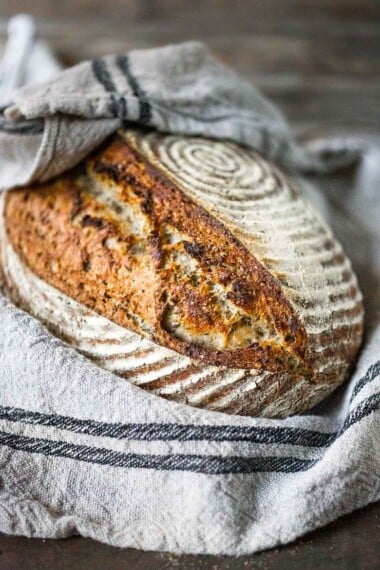

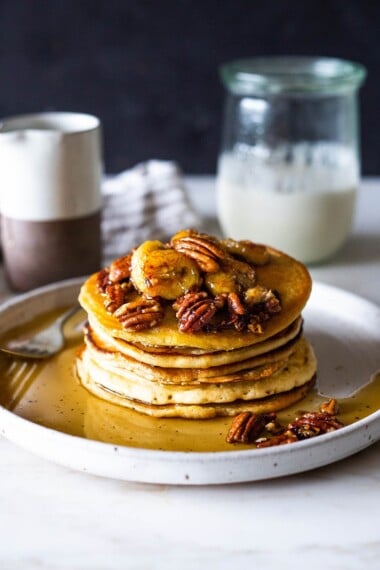
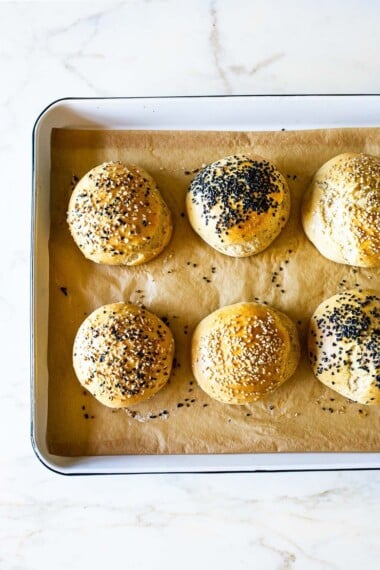







hi, this is my first attempt at making sourdough starter and sourdough bread, your recipes for both have been very educational, and i have already made 3 loafs of bread and this is my starters 14day, i think it was ready to bake at 6/7 day , but i used it on the 9th day and everything was fine, so far i have been feeding it 2 a day, since i wanted it to get a bit more established before i put it in the fridge (i don’t know if it was necessary but i was also gonna use it over the past weekend so i decided to leave it out) i also wanna share that i started the process when the temp was 15-20 °C max or 60-70°F, the temp suddenly dropped to 2°C or 35°F, with max being 7°C and 45°F during the day, and we just barely started heating up the place but my starter has been making me proud and doubling and even tripling constantly im not sure how long it takes it to peak because im never there whent t does but i think its about 8-10 hours but so far so good, i do know that before i used it the first time i made sure it doubled in 4-6 hours, but after that the temp dropped, so thank you for the detailed recipes, my question are 1. i feed it too late one day since it was a bit colder and it hadn’t risen by the time i needed to leave, i feed it once i came home 1/1/1 but it smells a bit like alcohol/acceton, so i fed it 1/3/3 last night to see if that would help but it still smells like acceton this morning, so how do i get rid of the smell, 2nd question is about storing it, since i will probably be using it once a week is it best to sync the days for feeding and the day i need the starter to bake, so i put it in the fridge as soon as i feed it ,but once i want to use it do i just take it out of the fridge DISCARD it feed it leave it out and than use it once its peeked (and than feed it again and put it back in the fridge) like you wrote, and than repeat the same next week
Hi Amila, I am so glad you are enjoying this recipe! I am trying to understand your questions! For your first question, when starter smells that acetate or alcohol, it needs to be feed sooner, it gets that way when it is super hungry. Question 2: You can store the starter in the fridge, once you feed it, and should be able use it to bake anytime from day 3-day 7 without feeding it. Or feel free to feed on day 7 in the am, let it peak and make dough that night. Hope that helps clarify?
If you’re using San Pellegrino, do you feed with it all the time? Or just the first day’s starter and use plain water the rest of the time? And you warm it to lukewarm, right?
Hi Rena, you can use it anytime your starter seems sluggish for a burst of minerals. I don’t warm it- just use at room temp.
Hello! I just want to clarify, I know you said you can use fresh milled flour instead of bread flour, but is that only after the initial week or can you use fresh milled throughout the whole process? Does the lack of shelf stability affect anything?
Hi Tessa, you can use freshly milled flour for any part of this! It is great that you have it!
I have starter in my fridge. Hasn’t been fed in a month, it was given to me and I wasn’t sure what to do with it and now I’m having the time to do the research to see what I have to do with it. What do I have to do with it before I can make this recipe?
Hi Melissa, I would just try feeding it- take it out of the fridge, discard all but ½ cup and start on “day two” of the feeding schedule and see if you can revive it. 🙂
Can she keep the other part in fridge to use like this again instead of ‘discarding’ it?
I just started rehydrating my Eden this morning. Think I will call mine Betty after my mom.
I don’t recommend it because after a month of not feeding the discard is probably not very healthy.
Wow! seems a bit daunting for a novice like me but I’m no quitter I’m off to get the ingredients and give it a shot thanks for the recipe and tips
Awesome Adrian, You can do it!
Previous attempts were unsuccessful until I tried yours. Many thanks
Thrilled to hear this Maria!
Hello, thanks for your recipe and great video. I’m a retired video production teacher. 🙂 My starter is in a room that is 76 degrees. I did a double feed on day three. On day four I didn’t see a hungry starter so I only fed once. On day five (yesterday), I followed the three troubleshooting suggestions (rye flour, Pellegrino mineral water, stirring a few times during a 12 hour period). There has been no doubling only a tiny bit of rising and sliding. I HAVE seen bubbling and some mounding. Starter smells good. Today is day 6. I fed the normal 120 grams bread flour, 120 H20 and 1/2 cup starter. Flour is King Arthur brand and also new. Any other suggestions besides patience?
I think you answered your own question…patience! Let it get really hungry, almost liquidy before the next feed?
Hi! My starter took over 2 days to rise and then 2 days to show any sign of falling. Should I have fed it when it rose and wasn’t falling? Thanks!
Nope- you did just fine! It’s best to be patient with it! Good job Erin!
This post helped me start my sourdough journey in May 2020 and my starter (her name is Lola!) is still going strong! Thank you!!!
Congratulations Jennifer and Lola!!!
I have always looked for a sourdough recipe for sandwich bread and have not come up with one yet that I think is a good one.
Also I would like some advice on a good storage container for flour that holds at least 20lbs. that would hopefully be fairly inexpensive. Thank You Holley Waller
I would check restaurant food storage containers.
Hi there! I was wondering, after my starter has been established, do I continue to feed it the same way? Keep 1/2 cup of starter, feed it 1 cup flour and 1/2 cup water? I fed it last night with the intention to make bread today and it didn’t rise very much. I started it about 2 weeks ago
Hi Nashay, yes correct, to maintain feed it the same way. Make sure to feed it only when hungry. You can try leaving it out of the fridge for a few days and see if you can get it to rise better.
finally, a a sourdough starter receipe that is easy to follow. Thank you, I will keep you posted on my first loaf.
Great to hear Deborah!
Hello!
First time making any kind of bread and I’m enjoying every minute!
I’m on day 5 of my starter and haven’t had to feed it twice a day yet. Today, I fed at 6 am, it’s 3 pm and it has more than doubled in size! (Almost at the top of my Weck jar). It has not started to fall yet, the consistency is still rather thick and the bubbles on top are not airy, more like lava or swamp bubbles.
Do I leave it go until the 12 hour mark? I fear it may take over my house at this point. 🙂
Heidi
Haha! Love hearing this Heidi. I would place it over a plate, just in case, and let it do it’s thing. Don’t watch the clock, just look for the signs of hunger and wait to feed until then. 🙂
I’ve tried several starters before and they always fail. This one so far is doing great. I am on day eight I fed it last night at 5 PM this morning. I got up. It’s almost ready to explode out of the jar. It smells great and passes the float test! It has not deflated yet, but I never did twice a day feedings because it would not rise and fall therefore, I didn’t think it was hungry. My questions are as follows:
1- Is it ok that I only did once a day feedings?
2-Am I ready to make bread? It hasn’t deflated and I have to work today. I’d like to bake on Thursday. Can you tell me what to do for that? Continue feeding? Place it in the fridge?
Hi Tina, great to hear! Yes it is OK if it only needs one feeding. It sounds like you are ready to bake. You could place it in the fridge until thursday morning, pull it out in the morning, feed it, and make the dough thursday night after it peaks. 🙂 Best of luck!
Hi! I am on day 2 and it looks great! Question – I don’t have “bread flour”. I have whole wheat or unbleached all purpose. Would that work?!
You can always try it? Maybe using both- ¾ AP, ¼ whole wheat. I always have the best luck with organic bread flour, but this is worth a shot!
I will be flying across country and would like to take my starter with me? What do you think?
Great! Should be ok?
Hi, have been making your sourdough bread for about a year now and going well. But recently when feeding starter it is rising and peaks but then never falls. It just stays peaked and that’s even after 24 hours! Can you tell me why please? Thankyou
Hi Bev, it just sounds really happy. 🙂 It will eventually fall, bu honestly I woulnt worry about it- sounds like you have a good starter!
Dehydrate some active starter. Easier to carry on plane or mail. I’ve already mailed some to a friend with instructions on how to revive. Plus you’ll always has some backup if something ever goes wrong, always have a plan B. John
Fern is doing well, 5th day and she’s right on target. I finally got a device to play video and and that helped a lot with monkey see, monkey do. I’d been struggling with a procedure but the video gave that to me. Taking far less time (and mess) to get through steps. Thanks John
Glad to hear it John!
Is it ok to use well water that has a softener system on it? It is much softer than usual “city” tap water but I’m wondering if this type will be good for sourdough starter. This will be my first time trying to make a sourdough starter, so I don’t want to waste time or money. ; )
Hi Pam- that is a great question, and honestly, I don’t know. I would just give it a try and see, I think you would get a pretty good idea after the first day?
I finally have a sourdough starter! It was quite sluggish for days so I added a little rye at feeding. I did 20 grams of organic dark rye and 100 grams of organic white flour and it just took off, bubbling, falling etc. I was able to make your bread too. Thank you Sylvia.
Hooray!!! I’m so happy for you- well done!
Oh I forgot to mention, I’m in SW Florida, temp is 75 deg in kitchen where it’s been sitting. And the smell is overall quite tangy with sweet end notes, so I think that’s good.
It sounds good!
Hi Sylvia. I am a subscriber and I think you do an amazing job on your site. In particular, this starter video! So thorough and excellent vid production. THANK-YOU! I tried w/ another youtube vid out there and ultimately failed. But, I’m so frustrated. I started this process on May 13th. I have done exactly as you suggest, right down to the same tools/equipment. I have not used it yet! And that’s because there was a major slow down, then I got it going again (using pelligrino (brilliant) and subbed out 1/3 rye flour). But it NEVER passes the float test. Goes right down to bottom of bowl. Unless I drizzle w/ a fork, then it floats a bit. Last night after feeding, some time in the night it tripled in size. then this A.M., after the slide, it still did not pass float test. What should I do at this point? I so want to bake bread, and especially pizza in our new Gozney. I truly appreciate any help. Teresa
Hi Teresa, thanks so much and sorry for the frustration. Try the float test when the start is at its peak, before it goes done. If still not floating, but doubling in size, then I would just give it a try and bake your first loaf!
Hi it’s day 3 and it’s rising but not bubbly and it’s thick I followed instructions as told but mine is different any tips?
Hi Dani- rising is good but if it is still very thick, it is not done processing the flour. I would let it go longer wtihout feeding. Read through the trouble shooting section – and make sure your measurments are correct. Let me know how it goes! 🙂
Great recipe. Thanks for the detailed instructions.
My first attempt at sourdough & its been a fun learning process.
I am looking for ideas on how to mix other add ins.
Like – cheddar/jalapenos
Any suggestions on to go about it?
Thanks
Hi Lynn! I would go to our Rosemary Olive loaf and follow that as a guide!
Hi, first time trying it.. on day 7 now but i got it bubbling and getting liquidy but no rising. Im feeding it every 12 hrs. Is there anything else i need to try? Thanks!
Hi Lucy, read throught the trouble shooting section- there are a bunch of things you can try listed there. It just may need more time?